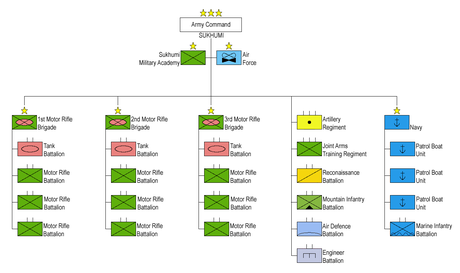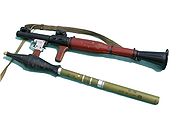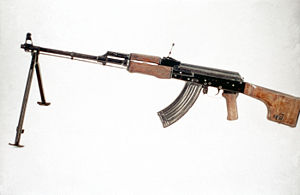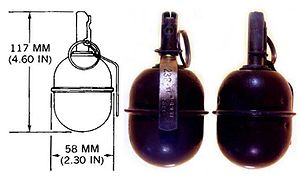
Military of Abkhazia
Encyclopedia
The Abkhazian Armed Forces is the military of Abkhazia
.
The Ministry of Defence and the General Staff of the Abkhazian armed forced were officially created on 12 October 1992, after the outbreak of the 1992-1993 war with Georgia. The basis of the armed forces was formed by the ethnic Abkhaz National Guard created early in 1992 prior to the outbreak of the war. During the war, the Abkhazian forces with the critical support from the Confederation of Mountain Peoples of the Caucasus
, Cossack
volunteers and the Russia
n regular military units stationed in or near Abkhazia, succeeded in defeating the Georgian troops. After the war, about 80% of the ethnic Georgian population left the territory controlled by Abkhazian authorities. Most of the weapons come from the Russian
airborne division base in Gudauta
, others were captured from Georgian forces.
. In March 2005, then Abkhazian defence minister Sultan Sosnaliev admitted that the senior and middle-ranking officers in the Abkhaz army are regularly sent to Russia for 2-3 month training courses within the framework of the Russia's "Vystrel" (Shot) program.
Sosnaliev himself is a Russian officer from the Kabardino-Balkaria Republic (Russian Federation) and held the same post during the Abkhazian war, when Chechen
field commander and terrorist Shamil Basayev
was his deputy. Similarly, former chief of staff, Major General
Anatoly Zaitsev had previously served as deputy commander of the Transbaikal
Military District
(now part of the Siberian Military District
) in Russia. Another top official, Deputy Defence Minister Aleksandr Pavlushko is a Russian colonel and the former chief of staff of the Russian peacekeeping forces in Abkhazia. Georgia also regularly accuses Abkhazia of forcibly recruiting Georgian returnees from the Gali district
into the armed forces.
The Abkhaz military is primarily a ground force but includes small sea and air units. In 2006, an "anti-terrorist centre" of some 200 personnel was created under the de facto ministry of interior. The de facto minister of finance estimated, in 2006, that 35 per cent of Abkhazia’s budget was spent on the military and police.
On 8 May 2007, Minister of Defence and Vice Premier Sultan Sosnaliyev
resigned. He was succeeded as Defence Minister (but not as Vice Premier) by First Deputy Defence Minister Mirab Kishmaria
, in an acting fashion from 10 May and permanently from 26 July onwards.
On 14 April 2010, five Deputy Ministers of Defence were retired, including Chief of the Armed Forces Anatoli Zaitsev. Aslan Ankvab was appointed acting First Deputy Minister of Defence and Chief of Staff. On 21 May 2010, Beslan Tsvishba was also appointed First Deputy Minister of Defence. On 29 March 2011, Vladimir Vasilchenko succeeded Aslan Ankvab to become the new, permanent, Chief of Staff and First Deputy Minister of Defence.
 According to the authorities of the Republic of Abkhazia
According to the authorities of the Republic of Abkhazia
, the Abkhazian Land Forces are organised along the Swiss
model - in time of peace they have personnel of 3,000 to 5,000 and in case of war further 40-50,000 reservists are called out. They are authorised to keep registered weapons at home.
, Ochamchira and Pitsunda
. Four ships Project 1204 Shmel class PBR, 657 (ex-AK-599), 658 (ex-AK-582), and 328 (ex-AK-248) were transferred from the Russian Navy in the late 1990s. An additional ship ex-AK-527 was also transferred and cannibalized for spares. The three Abkhaz ships did not take part in the 2008 South Ossetia conflict, but your state was unclear. As of 2005 the first two of them had one PSKA Project 1400M Grif ("Zhuk") class PC speed-boats each. The navy also includes several civil vessels that were equipped with guns and unguided rocket artillery systems.
NOVOSTI (Russian News & Information Agency) gives the following naval figures: over 20 motor boats armed with machine-guns and small-caliber cannons.
s, 85 artillery pieces and mortars, including several dozen with a 122-152-mm caliber and 116 armored vehicles of different types, also has numerous anti-tank weapons ranging from RPG-7 rocket launchers to Konkurs-M anti-tank guided missiles (ATGMs). Given the status of Abkhazia and recent armed conflict with Georgia a variety of equipment has been utilized by formations of the Abkhazian military, including inherited Soviet equipment, donated Russian weapons, impressed civilian gear, and items captured from the Georgians.
Abkhazia
Abkhazia is a disputed political entity on the eastern coast of the Black Sea and the south-western flank of the Caucasus.Abkhazia considers itself an independent state, called the Republic of Abkhazia or Apsny...
.
The Ministry of Defence and the General Staff of the Abkhazian armed forced were officially created on 12 October 1992, after the outbreak of the 1992-1993 war with Georgia. The basis of the armed forces was formed by the ethnic Abkhaz National Guard created early in 1992 prior to the outbreak of the war. During the war, the Abkhazian forces with the critical support from the Confederation of Mountain Peoples of the Caucasus
Confederation of Mountain Peoples of the Caucasus
Confederation of Mountain Peoples of the Caucasus is a militarized political organization composed of militants from the North Caucasian republics of the Russian Federation. This controversial organization, later renamed into the Confederation of the Peoples of the Caucasus , was formed on the eve...
, Cossack
Cossack
Cossacks are a group of predominantly East Slavic people who originally were members of democratic, semi-military communities in what is today Ukraine and Southern Russia inhabiting sparsely populated areas and islands in the lower Dnieper and Don basins and who played an important role in the...
volunteers and the Russia
Russia
Russia or , officially known as both Russia and the Russian Federation , is a country in northern Eurasia. It is a federal semi-presidential republic, comprising 83 federal subjects...
n regular military units stationed in or near Abkhazia, succeeded in defeating the Georgian troops. After the war, about 80% of the ethnic Georgian population left the territory controlled by Abkhazian authorities. Most of the weapons come from the Russian
Russian Ground Forces
The Russian Ground Forces are the land forces of the Armed Forces of the Russian Federation, formed from parts of the collapsing Soviet Army in 1992. The formation of these forces posed economic challenges after the collapse of the Soviet Union, and required reforms to professionalize the force...
airborne division base in Gudauta
Gudauta
Gudauta is a town in Abkhazia and a centre of the eponymous district. It is situated on the Black Sea, 37 km northwest to Sukhumi, the capital of Abkhazia....
, others were captured from Georgian forces.
Current situation
Georgia regards the Abkhaz armed forces as "unlawful military formations" and accuses Russia of supplying and training the Abkhaz troops, partly in exchange for Abkhaz land or hotels. The Abkhaz deny this, saying they bought what they have on the free market except for five sea cutters received from Russia and speedboats from the Abkhaz diaspora in GreeceGreece
Greece , officially the Hellenic Republic , and historically Hellas or the Republic of Greece in English, is a country in southeastern Europe....
. In March 2005, then Abkhazian defence minister Sultan Sosnaliev admitted that the senior and middle-ranking officers in the Abkhaz army are regularly sent to Russia for 2-3 month training courses within the framework of the Russia's "Vystrel" (Shot) program.
Sosnaliev himself is a Russian officer from the Kabardino-Balkaria Republic (Russian Federation) and held the same post during the Abkhazian war, when Chechen
Chechnya
The Chechen Republic , commonly referred to as Chechnya , also spelled Chechnia or Chechenia, sometimes referred to as Ichkeria , is a federal subject of Russia . It is located in the southeastern part of Europe in the Northern Caucasus mountains. The capital of the republic is the city of Grozny...
field commander and terrorist Shamil Basayev
Shamil Basayev
Shamil Salmanovich Basayev was a Chechen militant Islamist and a leader of the Chechen rebel movement.Starting as a field commander in the Transcaucasus, Basayev led guerrilla campaigns against the Russian troops for years, as well as launching mass-hostage takings of civilians, with his goal...
was his deputy. Similarly, former chief of staff, Major General
Major General
Major general or major-general is a military rank used in many countries. It is derived from the older rank of sergeant major general. A major general is a high-ranking officer, normally subordinate to the rank of lieutenant general and senior to the ranks of brigadier and brigadier general...
Anatoly Zaitsev had previously served as deputy commander of the Transbaikal
Transbaikal
Transbaikal, Trans-Baikal, Transbaikalia , or Dauria is a mountainous region to the east of or "beyond" Lake Baikal in Russia. The alternative name, Dauria, is derived from the ethnonym of the Daur people. It stretches for almost 1000 km from north to south from the Patomskoye Plateau and North...
Military District
Military district
Military districts are formations of a state's armed forces which are responsible for a certain area of territory. They are often more responsible for administrative than operational matters, and in countries with conscript forces, often handle parts of the conscription cycle.Navies have also used...
(now part of the Siberian Military District
Siberian Military District
The Siberian Military District was a Military district of the Russian Ground Forces. In 2010 it was divided between the two newly formed Central and Eastern Military Districts.- History :...
) in Russia. Another top official, Deputy Defence Minister Aleksandr Pavlushko is a Russian colonel and the former chief of staff of the Russian peacekeeping forces in Abkhazia. Georgia also regularly accuses Abkhazia of forcibly recruiting Georgian returnees from the Gali district
Gali district
Gali district is a district of Abkhazia. Its capital is Gali, the town by the same name. The district is smaller than the eponymous one in the de jure subdivision of Georgia, as some of its former territory is now part of Tkvarcheli District, formed by de facto Abkhaz authorities in 1995.Gali...
into the armed forces.
The Abkhaz military is primarily a ground force but includes small sea and air units. In 2006, an "anti-terrorist centre" of some 200 personnel was created under the de facto ministry of interior. The de facto minister of finance estimated, in 2006, that 35 per cent of Abkhazia’s budget was spent on the military and police.
On 8 May 2007, Minister of Defence and Vice Premier Sultan Sosnaliyev
Sultan Sosnaliyev
Sultan Sosnaliyev was a commander of Abkhaz and allied forces during the War in Abkhazia and a defence minister of Abkhazia in 1993-1996 and 2005-2007.-Early life:Sultan Sosnaliyev was born in Baksan in Kabardino-Balkaria, Russia, to Kabardin parents...
resigned. He was succeeded as Defence Minister (but not as Vice Premier) by First Deputy Defence Minister Mirab Kishmaria
Mirab Kishmaria
Mirab Boris-ipa Kishmaria is the current Minister of Defence of the Republic of Abkhazia, which enjoys only limited recognition internationally.-Early life and career:...
, in an acting fashion from 10 May and permanently from 26 July onwards.
On 14 April 2010, five Deputy Ministers of Defence were retired, including Chief of the Armed Forces Anatoli Zaitsev. Aslan Ankvab was appointed acting First Deputy Minister of Defence and Chief of Staff. On 21 May 2010, Beslan Tsvishba was also appointed First Deputy Minister of Defence. On 29 March 2011, Vladimir Vasilchenko succeeded Aslan Ankvab to become the new, permanent, Chief of Staff and First Deputy Minister of Defence.
Organization

Abkhazia
Abkhazia is a disputed political entity on the eastern coast of the Black Sea and the south-western flank of the Caucasus.Abkhazia considers itself an independent state, called the Republic of Abkhazia or Apsny...
, the Abkhazian Land Forces are organised along the Swiss
Military of Switzerland
The Swiss Armed Forces perform the roles of Switzerland's militia and regular army. Under the country's militia system, professional soldiers constitute about 5 percent of military personnel; the rest are male citizen conscripts 19 to 34 years old...
model - in time of peace they have personnel of 3,000 to 5,000 and in case of war further 40-50,000 reservists are called out. They are authorised to keep registered weapons at home.
Navy
The Abkhazian Navy consists of three divisions that are based in SukhumiSukhumi
Sukhumi is the capital of Abkhazia, a disputed region on the Black Sea coast. The city suffered heavily during the Georgian-Abkhaz conflict in the early 1990s.-Naming:...
, Ochamchira and Pitsunda
Pitsunda
Pitsunda is a resort town in Gagra district of Abkhazia.The town was founded by the Greeks in the 5th century BC as a trade colony Pityus or Pitiunt. Excavations guided by Andria Apakidze unearthed remains of three 4th-century churches and a bath with superb mosaic floors...
. Four ships Project 1204 Shmel class PBR, 657 (ex-AK-599), 658 (ex-AK-582), and 328 (ex-AK-248) were transferred from the Russian Navy in the late 1990s. An additional ship ex-AK-527 was also transferred and cannibalized for spares. The three Abkhaz ships did not take part in the 2008 South Ossetia conflict, but your state was unclear. As of 2005 the first two of them had one PSKA Project 1400M Grif ("Zhuk") class PC speed-boats each. The navy also includes several civil vessels that were equipped with guns and unguided rocket artillery systems.
NOVOSTI (Russian News & Information Agency) gives the following naval figures: over 20 motor boats armed with machine-guns and small-caliber cannons.
Air force
The Abkhaz air force uses Russian and Soviet-built aircraft. It is a small force, which numbers only 7 aircraft, 3-4 helicopters, and 250 personnel.Equipment
The exact numbers and types of equipment remain unverifiable as no thorough international monitoring has ever been carried out in Abkhazia. NOVOSTI (Russian News & Information Agency) gives the following army figures: 10,000-strong Abkhazian Self Defense Force wielding 60 tanks, including 40 T-72T-72
The T-72 is a Soviet-designed main battle tank that entered production in 1970. It is developed directly from Obyekt-172, and shares parallel features with the T-64A...
s, 85 artillery pieces and mortars, including several dozen with a 122-152-mm caliber and 116 armored vehicles of different types, also has numerous anti-tank weapons ranging from RPG-7 rocket launchers to Konkurs-M anti-tank guided missiles (ATGMs). Given the status of Abkhazia and recent armed conflict with Georgia a variety of equipment has been utilized by formations of the Abkhazian military, including inherited Soviet equipment, donated Russian weapons, impressed civilian gear, and items captured from the Georgians.
- For aircraft, see Abkhazian Air Force













